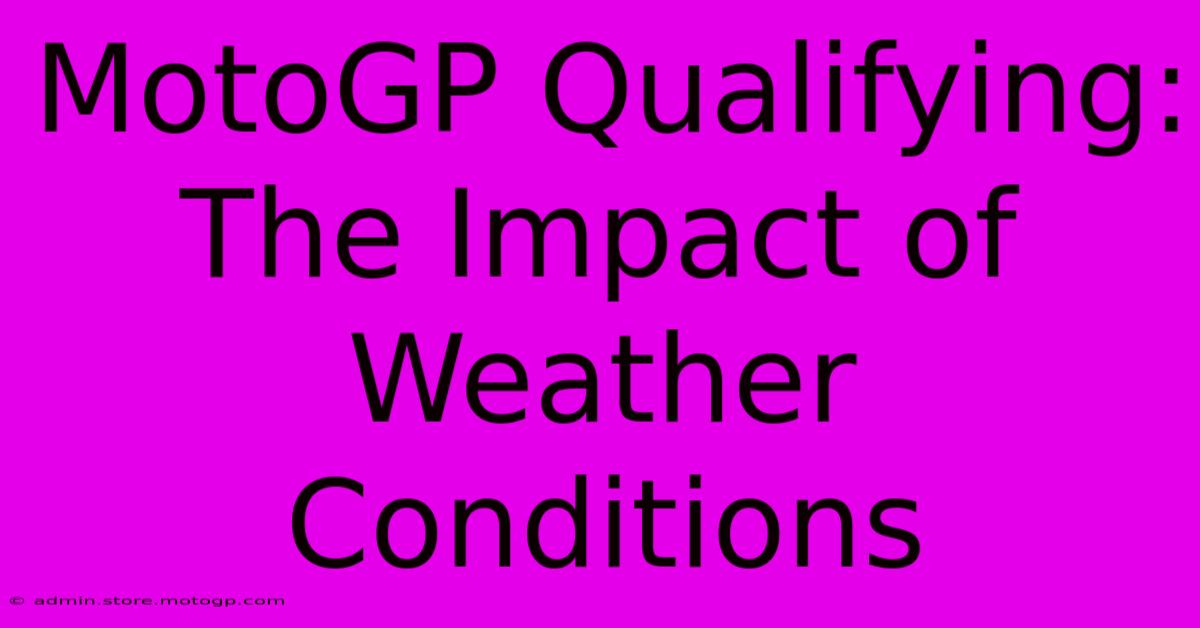MotoGP Qualifying: The Impact Of Weather Conditions

Table of Contents
MotoGP Qualifying: The Impact of Weather Conditions
MotoGP qualifying is a high-stakes game of precision and speed, a crucial determinant of grid position for the race. But the unpredictable nature of weather can dramatically alter the dynamics of a qualifying session, impacting strategies, results, and even rider safety. Understanding how weather conditions affect MotoGP qualifying is key to appreciating the skill and adaptability of these world-class racers.
The Role of Weather in Qualifying
The impact of weather on MotoGP qualifying is multifaceted. From track temperature to precipitation, several elements can significantly influence rider performance and team strategies.
1. Track Temperature:
- Optimal Temperatures: Ideally, MotoGP qualifying sessions take place under optimal track temperatures. This allows for optimal tire grip and consistent bike performance. Teams meticulously study weather forecasts to predict these conditions.
- High Temperatures: Excessive heat can lead to increased tire degradation, making it challenging to maintain lap times throughout a qualifying session. Riders may need to manage their tire pressures and riding styles accordingly. This can lead to more conservative qualifying strategies.
- Low Temperatures: Conversely, low temperatures can negatively affect tire warm-up, making it difficult to achieve optimal grip, especially at the start of a session. Cold conditions might necessitate extra warm-up laps or different tire compounds.
2. Precipitation (Rain):
Rain introduces a whole new level of complexity to MotoGP qualifying.
- Wet Conditions: Wet qualifying sessions demand a completely different approach. Riders switch to wet-weather tires with deeper treads for better grip on a water-saturated track. Visibility is often reduced, and aquaplaning becomes a significant risk. The qualifying times are naturally slower and the margin for error dramatically decreases.
- Mixed Conditions: The most challenging scenario is often mixed conditions – parts of the track wet, parts dry. This requires riders to adapt their lines and riding styles constantly, as grip levels fluctuate drastically across the circuit. This necessitates superior judgment and skill from the rider and shrewd tire choices from the team.
- Sudden Downpours: A sudden downpour during a qualifying session can instantly disrupt proceedings, potentially causing crashes and forcing delays. Teams must react quickly to change strategies, deciding whether to wait out the storm or attempt a quick run on drying track conditions.
Strategic Implications of Weather
Weather forecasts play a crucial role in shaping team strategies during MotoGP qualifying.
- Tire Selection: The most significant strategic decision is tire choice. Teams meticulously analyze weather predictions to select the appropriate tires – slicks for dry conditions, wet tires for rain, and potentially intermediate tires for mixed conditions. The risk of choosing the wrong tire can be disastrous.
- Fuel Load: While qualifying laps are relatively short, fuel load still impacts bike performance and handling. In extreme weather conditions, the extra weight of a larger fuel load might be a significant factor to consider.
- Track Position: The part of the track affected by weather first can influence track position during qualifying. If one section is particularly wet, riders might adjust their lines and attempts to avoid that section until it dries.
The Human Factor: Rider Skill and Adaptability
Ultimately, however, the success of a MotoGP qualifying session in challenging weather conditions hinges on the rider's skill and adaptability. Experienced riders possess the judgment to make quick decisions based on the evolving weather and track conditions, adjusting their riding style accordingly. They can extract maximum performance from the machine even in the most treacherous conditions.
Conclusion: Weather's Undeniable Influence
Weather conditions represent a critical variable in MotoGP qualifying. Understanding the impact of track temperature and precipitation is essential to analyzing race strategies, appreciating rider performance and the overall drama of the qualifying sessions. The ability to adapt to these ever-changing conditions is crucial in distinguishing between championship contenders and the rest of the grid. The unpredictable nature of weather adds another layer of excitement and complexity to the already exhilarating world of MotoGP.

Thank you for visiting our website wich cover about MotoGP Qualifying: The Impact Of Weather Conditions. We hope the information provided has been useful to you. Feel free to contact us if you have any questions or need further assistance. See you next time and dont miss to bookmark.
Featured Posts
-
Cota Qualifying Your Ticket To The Main Event
Feb 18, 2025
-
How Moto Gp Bikes Handle Extreme Braking At High Speeds
Feb 18, 2025
-
The Psychology Of Motorcycle Riding Explored By Famous Riders
Feb 18, 2025
-
Transform Your Life With Cota Lot H
Feb 18, 2025
-
Navigating The Austin F1 Transportation Tips For Locals
Feb 18, 2025
